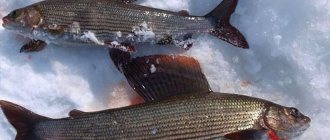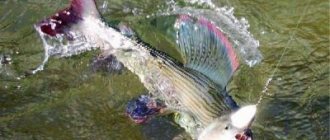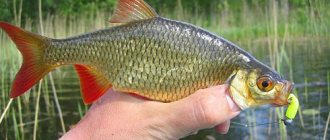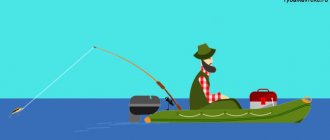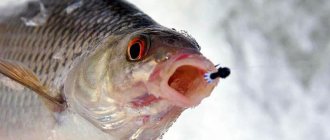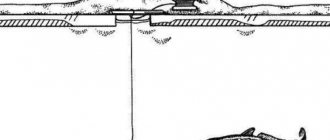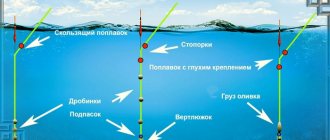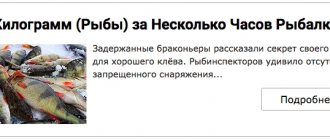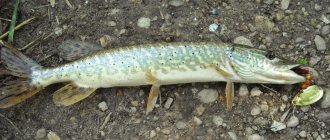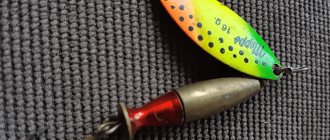Features of fishing on the current
Any river, be it small or large, is a promising reservoir for winter fishing. However, fishing here is much more difficult than in closed areas with standing water. The current makes certain adjustments to fishing tactics and techniques and requires other gear and equipment.
There are many promising spots on the river where you can count on catching fish. The most interesting are:
- pits and pools;
- snags;
- channel slopes and rifts;
- edges and slopes;
- long coastal ditches.
The fish likes to stand in the area where small tributaries, streams, entrances to oxbow lakes and backwaters, outlets of branches and branches flow into the main channel. It can be found near bridges, piers and other hydraulic structures. As you can see, the places are very diverse. Everyone, if desired, will find their cherished point.
Fishing in winter on the current begins later than on “still” reservoirs, which is explained by the late establishment of ice of a safe thickness. For the same reason it is closed earlier. Fishing is still in full swing in closed water areas, but the riverbed has already opened up.
Search tactics
If I don’t find fish quickly, then I don’t sit on the same holes, but I don’t run like crazy all over the backwater. I choose the golden mean, although I like to run on ice, with an eye on active balance fishing. I try to calculate the most promising points, and usually start from the deepest places, 3-4 meters, where the largest fish often take. If there is nothing, then I move to 2 m, where the fishing is quite comfortable, pleasant, but the chances of a large fish are already lower. I usually don’t fish in backwater areas smaller than 1.5 m; there is a dominance of small fish there.
Read: Winter fishing. Drilling holes
When different depths do not bring bites, I begin to work in areas, moving in a zigzag along the edge of the backwater, looking for fish at random. If there are no bites, then I fish more closely at the points that interest me - small holes, tubercles. In any case, during a fishing trip I make no more than 40-50 holes - either there is a fish, or there is simply nowhere to drill, the backwater is small, and then I just wait in the places where the bites were pleasing on previous fishing trips. And I certainly won’t leave the area if there was a bite here today, but “swimmed away” - there is a high probability that the fish will come here again, and more than once.
What kind of fish do they catch?
Fishing on the river in winter is carried out both for peaceful underwater inhabitants and for predators. Among the latter, the penguins’ catches include pike perch, pike, bersh, and perch. From December to February, targeted hunting for burbot begins, which becomes more active with the arrival of severe frosts.
Rolling fishing in winter: tackle and technique
Catching white fish is no less effective. The main catch of fishermen is:
- bream;
- silver bream;
- roach;
- blue;
- white-eye;
- bleak.
They also hunt for ruff, podust, nosar, and ide. In some regions, dace is actively caught. Even carp and heavy crucian carp can take the bait.
Bite stability
A variety of fish are constantly hanging around the edge of the backwater, and the migratory river fish like to look here, and the sedentary backwater fish come in, especially in the depths of winter, when the lack of oxygen drives them to fresh water. Accordingly, there is no great need for a wide search for fish. It’s on the riverbed itself that you need to run headlong if you want to find decent fish, and along the edge of the backwater you just wait for the schools to arrive in a local area, working a little with the drill. At the same time, the bite is an order of magnitude more stable than on the riverbed itself. It bites well on silver bream, roach up to 400 g, large dace, roaches and breams. Often, among the white fish, good perches of 400-500 g slip through, and closer to spring, chub and full-sized ide can be blessed with a bite.
In winter, a longing for a spinning rod periodically awakens in my soul, and then, greatly missing pike perch, asps and pike, I grab the balance beam and run more widely around the backwater, it often happens that I snatch a hefty pike or two, but here it depends on my luck. With a jig, of course, everything is more reliable, and there is enough fish for the home table, both fried and dried.
I like the very nature of the bite. This is not at all that kind of bite from the category “sometimes very thick, sometimes completely empty,” when dense schools of whitefish briefly enter the backwater, stimulating the exit of a crowd of fishermen, when almost everyone is caught, but just as quickly everything ends with the schools leaving for the river. These are not endless fishing races for constantly migrating fish along the large and deep backwaters of very large rivers. We have a good bite with quite rare bites, but for the most part all the fish are good sizes. Often the daily catch does not exceed two or three kilograms, but it consists of 5-10 fish, which are a great pleasure to fish out on a thin line. I choose a promising nickle on the ice, 20-30 meters in diameter, and “peck” it for the entire fishing trip, which is somewhat reminiscent of my favorite spinning rod, where every bite is unique and unforgettable.
Read: Features of bait on the last ice
Maximum fish activity on the first ice is about two weeks. And on the last ice, when on many old rivers there is no bite due to poor oxygen conditions, and on the river the ice is already breaking off, while on the edge of the backwater, it can be a lot of fun, and there is the greatest chance of catching something truly worthy .
In the midst of winter, fishing on the backwaters is worse, but you can’t say that the edge of the backwater covers the dead of winter, and only small jigs are poorly caught. There is no such thing here - if there are small things, then I just leave in search of normal fish.
It is rare, but it happens that the edge of the backwater does not work. Or the ice simply becomes “rotten” during a prolonged thaw. Then I go deeper into the backwater, closer to the shore, where small perch reign, but even among them I almost always manage to find striped ones of 150-200 g. And when the strength of the ice on the edge is restored, I move there again.
Tackle
For fishing in the current I use different gear, but, obviously, they are all heavy, since it is necessary to lower the bait to the bottom and hold it there for a certain time. Light equipment will “fly up” under the influence of the jet and you won’t even dream of catching anything.
To catch white fish in the current, various bottom and float equipment are used:
- ends;
- slope;
- helicopter;
- standing fishing rod with nod;
- float rod.
- garland.
Each tackle has its own characteristics, advantages and disadvantages, and is used in different situations and for targeted hunting of different fish.
The predator's fishing is no less multifaceted. But the main directions are vertical lures and girders. In the first case, various artificial baits are used, from classic “verticals” and balancers to specific wasps and amphipods. In the second, the equipment is loaded with live bait, which is caught directly on the reservoir or brought with them already prepared.
All river gear is subject to more stringent requirements. All other things being equal, they should be stronger and more reliable than for hunting in closed reservoirs, since the flow of water affecting the equipment at the time of catching and landing fish leaves its mark.
As a rule, fishing lines with a thickness of 0.20 mm and a breaking load of over 3 kg are used on the river. The fishing rods are rigid, most are tall, and have a length of 70 cm. The reels are open type, reliable and powerful. The weight of the equipment in the current is rarely less than 20 grams.
Equipment options
Together with the competent selection of the float (nod) and the weight of the equipment, the installation itself and experiments with it are the basis of tactics on the current. The following may work better or worse under different conditions:
- Blind equipment with a retractable leash;
- Sliding tackle (inline);
- Combined options.
The essence of the correct tactics for ice fishing on the current is a combination of active search and constant experimentation with equipment options until a working connection is found.
Retractable leash
On weak drafts, a winter fishing rod rig for fishing in currents with a blind sinker and a retractable leash (or several) works better. This installation method can be implemented using several methods.
- A regular diverter leash on a knot;
- Paternoster (Gardner loop);
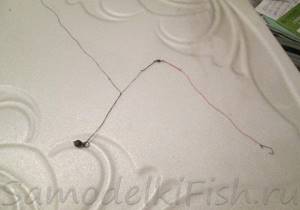
- Asymmetrical loop;
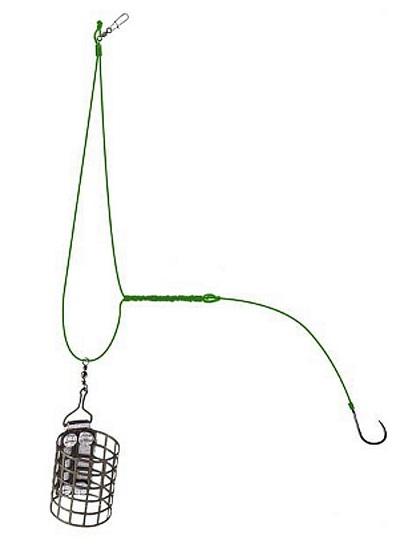
- Denisov hinge;
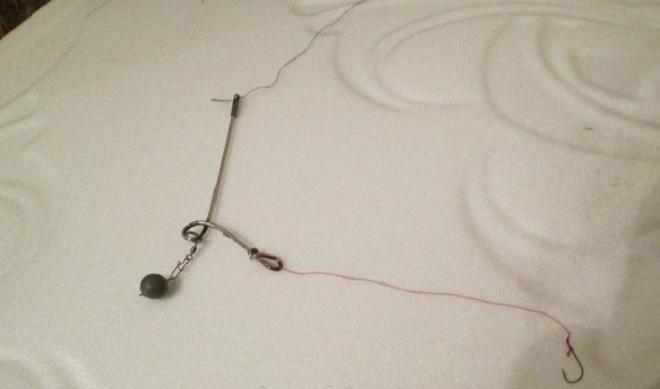
- Helicopter (sliding leash).
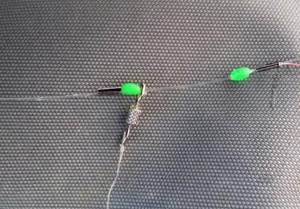
The fisherman’s task is to experimentally select a working installation for specific conditions. Each specific equipment listed is also selected. The distance to the sinker or the length of the leash itself changes. We ensure that the hook with the bait does not dangle in the water column, but lies on the bottom and moves with the current. This can be achieved, depending on the strength of the current, by changing the distance from the sinker to the point where the outlet is attached, by varying the length, or by using additional loading of the fishing rod leads with pellets or jigs. Attaching the leash to the fishing line (in the case of conventional tying) is done with various knots - grinner, uni, bloody, fishing loop through a knot. Read more in the article about winter equipment for fishing rods. This installation works well on low draft. If the current is stronger, the equipment in the sliding version will be more sensitive.
Sliding sinker (inline)
The stronger the current, the smaller the distance from the attachment point to the sinker in a blind rig with a diverting leash needs to be made. However, the smaller this distance, the worse the sensitivity of the fishing rod. Therefore, in stronger currents it is advisable to use a sliding sinker. When biting, the fish pulls the line through it and directly acts on the nod (float).
An ordinary olive with a through hole is used as a sinker; the weight is selected depending on the depth and strength of the current, from 5 to 20 grams. The fishing line is passed through the hole, and a pellet or silicone stopper is attached to it. The stopper is made sliding - you also need to constantly experiment with the length of the leash, choosing a working option. Such equipment of a winter fishing rod remains sensitive in the current with a fairly strong draft.
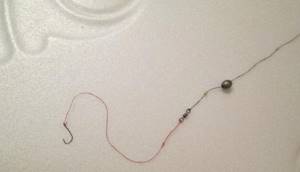
A small life hack - placing a foam ball 2-5 cm from the hook. This device is useful on a littered bottom, raising the hook so that it does not cling to algae. In a strong current, the ball puts additional stress on the leash, stretching it along the flow.
Combined options
Installation of winter fishing rods for fishing on currents is not limited to these options. Sometimes you need to check both the water column and the bottom at the same time, especially for roach in rivers. This is especially true when fishing for mixed-feed fish – roach, blue bream. Even bream and crucian carp sometimes prefer to take bait not from the bottom, but at some distance from it. In addition to the length of the leash, the angler needs to experiment with the fishing horizon. To do this, the diverter leash is made on stoppers in a sliding version, so that its height above the bottom can be changed. You can also add a retractable leash above the sliding sinker to the inline.
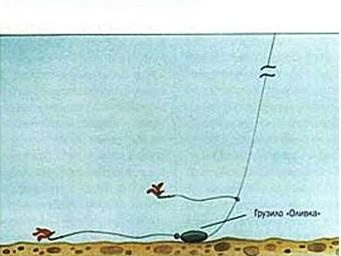
Techniques for catching white fish
Fishing in the current is quite easy. With some experience, the flow of water has a positive effect on the equipment, further stimulating the fish to bite. As a rule, no ornate wiring is carried out on the river.
The main animation techniques are:
- tapping on the bottom;
- stirring at the bottom;
- smooth swaying;
- a leisurely monotonous rise and subsequent descent of the bait.
For winter fishing of bream with a feeder, no wiring is required at all. The equipment is installed at the bottom by using a sinker of the required weight. The hook is located above the load and moves due to the force of the current.
Regardless of fishing methods, the bite in the current is always confident. The fish does not behave as carefully as in “still” reservoirs, because it is afraid of losing its prey. Therefore, idle contacts are rare, even when fishing for fastidious roach.
Fishing in a current is a little more difficult than in a standstill, all due to the same presence of current. The flow of water increases the resistance of the fish caught on the hook and makes it difficult to insert the equipment into the hole vertically. In this situation, you should never rush, trying to bring your prey to the ice as slowly and carefully as possible.
Features of postings
The favorite, most successful wiring option is somewhat similar to a very short jig step, only the jig moves with the flow. Initially, I will “catch” the bottom by selecting the weight of the jig so that it is carried only a little away from the hole, a maximum of half a meter. Let’s say a jig of 0.5 g carries further, then I’ll set it to 0.7 g and check, since a gram jig may be too heavy, not allowing for proper wiring.
After contact with the bottom, he quite sharply raised the fishing rod by 5-10 cm and immediately lowered it to the original one, while the current picks up the slack and moves the jig a little until the next contact with the bottom, and so on, rise - reset, rise - reset. Bottom strikers are required; without them, fishing will not work. Ideally, it would be good to hit the bottom about 20 cm 3-4 times, that is, each “step” is about 5-7 cm. If you don’t regularly hit the bottom, I’ll change the bait to a slightly heavier one.
You can follow the current for a long time, at least 10-15 m. But I don’t see the point - the further the jig goes, the worse the bites are visible, which are very fast, because there is nothing edible on the hook, and the fish instantly spits out the inedible, not always being detected. And I usually lead no further than 3-5 m. Most of all, I like the distance of 1-2 m - this is the best option. It is not profitable to fish very close to the hole - there are fewer bites here, and the fish are smaller, with the exception of perch, this one takes you from under your feet no worse.
I don’t see the point in fiddling with the reverse wiring, against the current, and if I don’t get the bite, then I just reel in the jig to make the next step downstream. Fortunately, there is no need to check the safety of the bait on a reelless bait.
Briefly about predator fishing
Catching predators with artificial bait differs from fishing in closed reservoirs. The current affects the play of the spinner or balancer. Therefore, the angler can withstand a longer pause, which has a positive effect on the desire of passive fish to attack the tasty object.
When fishing for pike perch, the strokes are made no higher than 30 cm. They can be both sharp and accelerated. The stop between lifting the rod is from 3 to 30 seconds. It depends on the mood of the fanged one and its desire to respond to bait.
Advice! When catching pike perch with sprat, the pause between strokes of the rod can reach up to a minute.
Pike prefers a smooth game with stops from 5 to 15 seconds. The spoon is lifted up to half a meter and carefully dropped. Perch responds better to short throws with minimal pauses. If it is passive, then the bait’s wiring should be softened as much as possible.
Suitable tackle
In recent seasons, I switched to balalaikas, considering them the best option for myself, abandoning fishing rods with a separate handle. I adjust the clamping screw so that the line is more or less freely pulled from the reel, and I do not change the adjustment during fishing. Then, after hooking, the tackle is always ready for the hooked fish to jerk, protecting the line from breaking. And I simply prevent the reel from turning during hooking with my hand.
In choosing the diameter of the fishing line, I moved away from extremes. From the “river” 0.14-0.18 mm it first spread to 0.08 mm, but the cliffs tormented me. In the end I settled on 0.10-0.12 mm, more often I use 0.10 mm. Thicker lines reduce the number of bites, or they are simply not as confident, and the implementation is much worse. Apparently, the performance of the jig is beginning to deteriorate, which is especially noticeable in the roach. Although gram jigs already work fine with 0.12 mm.
I select the nod not only according to personal preferences, but also with an eye on the weak current, trying to make it an ally and not an adversary in the game with fish. Dacron nods of medium length work best for me, around 8-10 cm. Some people successfully fish with longer ones, as much as 20-25 cm, but their main drawback bothers me - in the wind the whole game gets lost when fishing from a box, but I don’t really want to crawl on ice on my knees.
The optimal bending angle of the nod under the weight of the jig is 45 degrees, without load it is straight, being a continuation of the line of the rod’s whip. In this version, the nod works well both for bites on the rise, when the fish goes against the current, and when bending down.
